
SS Princess Alice, formerly PS Bute, was a British passenger paddle steamer that sank on 3 September 1878 after a collision with the collier SS Bywell Castle on the River Thames. Between 600 and 700 people died, all from Princess Alice, the greatest loss of life of any British inland waterway shipping accident. No passenger list or headcount was made, so the exact figure of those who died has never been known.
Viscount Allendale, of Allendale and Hexham in the County of Northumberland, is a title in the Peerage of the United Kingdom. It was created on 5 July 1911 for the Liberal politician Wentworth Beaumont, 2nd Baron Allendale. The title of Baron Allendale, of Allendale and Hexham in the County of Northumberland, had been created in the Peerage of the United Kingdom on 20 July 1906 for his father, the Yorkshire mining magnate and Liberal Member of Parliament, Wentworth Beaumont. The first Viscount's son, the second Viscount, notably served as Lord Lieutenant of Northumberland between 1949 and 1956. As of 2017 the titles are held by the latter's grandson, the fourth Viscount, who succeeded his father in 2002.
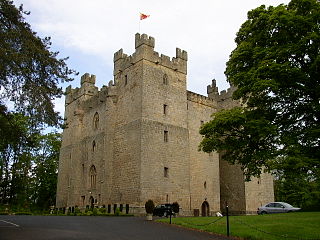
Langley or Langley-on-Tyne is a small village in Northumberland, England, located to the west of Hexham.

Stocksfield is a small commuter village situated close to the River Tyne, about 14 miles (23 km) west of Newcastle upon Tyne in the southern part of Northumberland, England. There are several smaller communities within the parish of Stocksfield, including Branch End, New Ridley, Broomley, Hindley and the Painshawfield Estate. Other villages in Stocksfield's postal district include Bywell, Newton, Mickley, and Hedley on the Hill.

Bywell is a village and civil parish in Northumberland, England. It is situated on the north bank of the River Tyne opposite Stocksfield, between Hexham and Newcastle. The parish has a population of around 380 and Newton is now its most populous settlement.

Coupland is a village and former civil parish, now in the parish of Ewart, in Northumberland, England. It is on the north bank of the River Glen about 4 miles (6 km) to the northwest of Wooler. In 1951 the parish had a population of 216.

Langley Castle is a restored medieval tower house, now operated as a hotel, situated in the village of Langley in the valley of the River South Tyne some 3 miles (5 km) south of Haydon Bridge, Northumberland, England. It is a Grade I listed building.
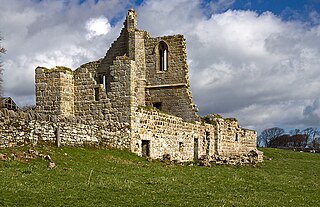
Cartington Castle is a ruinous, partly restored medieval English castle in the hamlet of Cartington, 2 miles (3.2 km) north-west of Rothbury in the county of Northumberland, England looking down on the River Coquet. It is a Scheduled Ancient Monument and a Grade I listed building.
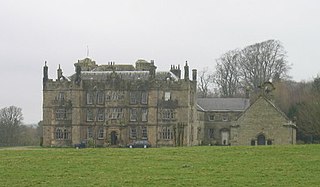
Chipchase Castle is a 17th-century Jacobean mansion incorporating a substantial 14th-century pele tower, which stands north of Hadrian's Wall, near Wark on Tyne, between Bellingham and Hexham in Northumberland, England. It is a Scheduled Ancient Monument and a Grade I listed building.
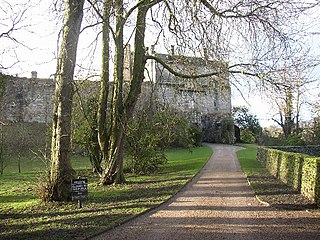
Cockermouth Castle is in the town of Cockermouth in Cumbria on a site by the junction of the Rivers Cocker and Derwent. It is a Grade I listed building and a scheduled monument.

Ford Castle is a Grade I listed building situated at a shallow crossing point on the River Till, Ford, Northumberland, England.

Featherstone Castle, a Grade I listed building, is a large Gothic style country mansion situated on the bank of the River South Tyne about 3 miles (5 km) southwest of the town of Haltwhistle in Northumberland, England.
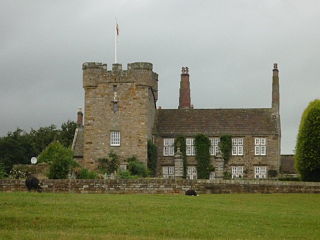
Halton Castle is a pele tower and grade I listed building situated close to Hadrian's Wall to the north of the village of Corbridge in Northumberland, England.

Harbottle Castle is a ruined medieval castle situated at the west end of the village of Harbottle, Northumberland, England, 9 miles (14 km) west-north-west of Rothbury overlooking the River Coquet. It is a Scheduled Ancient Monument and a Grade I listed building.

Bywell Hall is a privately owned 18th-century country house situated on the north bank of the River Tyne at Bywell, Northumberland, England. It is a Grade II* listed building.

Bywell Bridge is a 19th-century stone bridge across the River Tyne. It is a Grade II listed building.

St Andrew's Church is an Anglican church in the village of Bywell, Northumberland, England. It is recorded in the National Heritage List for England as a designated Grade I listed building, and is under the care of the Churches Conservation Trust.

Newton is a village and former civil parish, now the parish of Bywell in Northumberland, England. It is situated close to the A69 road, 3 miles (5 km) north of Stocksfield and 13 miles (21 km) west of Newcastle upon Tyne. In 1951 the parish had a population of 78. Bywell parish has a population of around 450 and Newton is its most populous settlement. Newton, Newton Hall and Stelling were three separate civil parishes from 1866 to 1955, when they were merged into the existing Bywell civil parish.

Bywell Castle was a passenger and cargo ship that was built in 1869 by Palmers Shipbuilding and Iron Company, Jarrow, County Durham. She was involved in the Princess Alice Disaster in September 1878 in which more than 600 people died. She disappeared in February 1883 whilst on a voyage from Alexandria, Egypt to Hull, Yorkshire, United Kingdom.


















